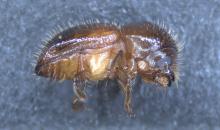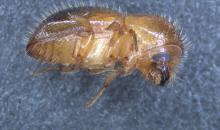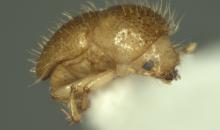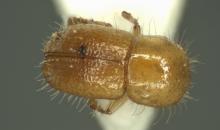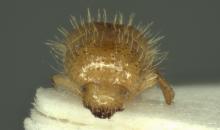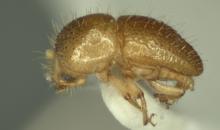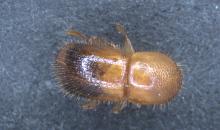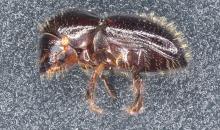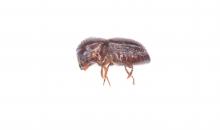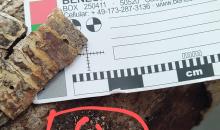Euwallacea fornicatus sensu lato(XYLBFO)
Photos
For publication in journals, books or magazines, permission should be obtained from the original photographers with a copy to EPPO.
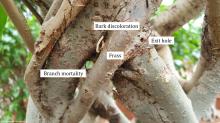
Symptoms of Euwallacea fornicatus sensu lato
Courtesy: Wietse den Hartog NVWA (NPPO the Netherlands)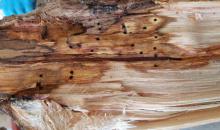
Symptoms of Euwallacea fornicatus sensu lato
Courtesy: Bas van de Meulengraaf NVWA (NPPO the Netherlands)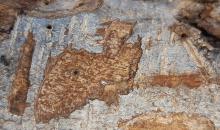
Symptoms of Euwallacea fornicatus sensu lato
Courtesy: Bas van de Meulengraaf NVWA (NPPO the Netherlands)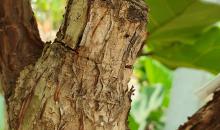
Symptoms of Euwallacea fornicatus sensu lato
Courtesy: Wietse den Hartog NVWA (NPPO the Netherlands)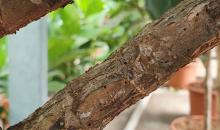
Symptoms of Euwallacea fornicatus sensu lato
Courtesy: Wietse den Hartog NVWA (NPPO the Netherlands)
Symptoms of Euwallacea fornicatus sensu lato
Courtesy: Wietse den Hartog NVWA (NPPO the Netherlands)
Symptoms of Euwallacea fornicatus sensu lato
Courtesy: Wietse den Hartog NVWA (NPPO the Netherlands)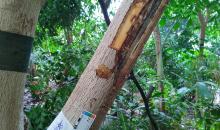
Magnolia champaca after sampling for Euwallacea fornicatus sensu lato with signs of Neocosmospora euwallaceae
Courtesy: Toralf Pfannenstill, Plant Health Inspection, State Office for Rural Development, Agriculture and Land Reallocation, Brandenburg, Germany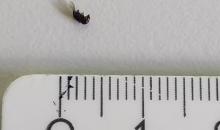
Adult specimen of Euwallacea fornicatus sensu lato (comparison object) - centimeter measure
Courtesy: Toralf Pfannenstill, Plant Health Inspection, State Office for Rural Development, Agriculture and Land Reallocation, Brandenburg, Germany
On Magnolia champaca, resin droplets above bore holes
Courtesy: Toralf Pfannenstill, Plant Health Inspection, State Office for Rural Development, Agriculture and Land Reallocation, Brandenburg, Germanyoralf Pfannenstill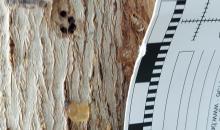
Bore holes and resin droplets on Magnolia champaca of Euwallacea fornicatus sensu lato
Courtesy: Toralf Pfannenstill, Plant Health Inspection, State Office for Rural Development, Agriculture and Land Reallocation, Brandenburg, Germany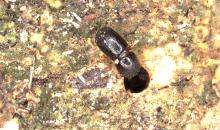
on Sterculia nobilis, adult on bark
Courtesy: Lukas Heringer, Chamber of Agriculture, North Rhine-Westphalia, Germany
on Dombeya cacuminum, gallery with adults
Courtesy: Lukas Heringer, Chamber of Agriculture, North Rhine-Westphalia, Germany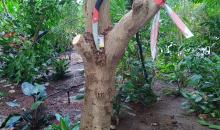
Magnolia champaca after sampling for Euwallacea fornicatus sensu lato
Courtesy: Toralf Pfannenstill, Plant Health Inspection, State Office for Rural Development, Agriculture and Land Reallocation, Brandenburg, Germany
Magnolia champaca, bore holes, ca. 1 mm in diameter of Euwallacea fornicatus sensu lato
Courtesy: Toralf Pfannenstill, Plant Health Inspection, State Office for Rural Development, Agriculture and Land Reallocation, Brandenburg, Germanyralf Pfannenstill
Bore holes and resin droplets on Magnolia champaca of Euwallacea fornicatus sensu lato
Courtesy: Toralf Pfannenstill, Plant Health Inspection, State Office for Rural Development, Agriculture and Land Reallocation, Brandenburg, Germany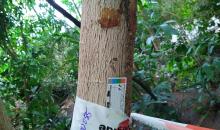
Magnolia champaca after sampling for Euwallacea fornicatus sensu lato with signs of Neocosmospora euwallaceae
Courtesy: Toralf Pfannenstill, Plant Health Inspection, State Office for Rural Development, Agriculture and Land Reallocation, Brandenburg, Germany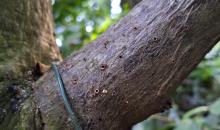
On Adansonia digitata, branch with boreholes
Courtesy: Lukas Heringer, Chamber of Agriculture, North Rhine-Westphalia, Germany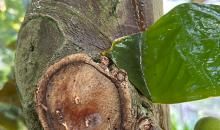
on Ficus aspera, trunk with boreholes and frass
Courtesy: Lukas Heringer (Photo by Louis Wintz), Chamber of Agriculture, North Rhine-Westphalia, Germany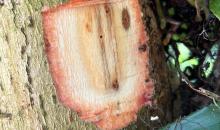
on Sterculia nobilis, trunk with boreholes under the bark and fungus
Courtesy: Lukas Heringer (Photo by Louis Wintz), Chamber of Agriculture, North Rhine-Westphalia, Germany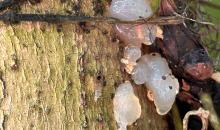
on Sterculia nobilis, trunk with resin flow
Courtesy: Lukas Heringer (Photo by Louis Wintz), Chamber of Agriculture, North Rhine-Westphalia, Germany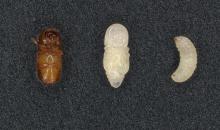
Life stages, larva, pupa and adult
Courtesy: Lukas Heringer, Chamber of Agriculture, North Rhine-Westphalia, Germany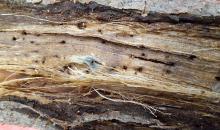
On Adansonia digitata, branch with boreholes under the bark
Courtesy: Lukas Heringer, Chamber of Agriculture, North Rhine-Westphalia, Germany
On Adansonia digitata, trunk with resin flow
Courtesy: Lukas Heringer, Chamber of Agriculture, North Rhine-Westphalia, Germany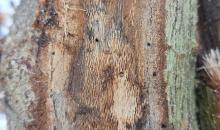
Sterculia nobilis, branch sample with boreholes under the bark
Courtesy: Lukas Heringer, Chamber of Agriculture, North Rhine-Westphalia, Germany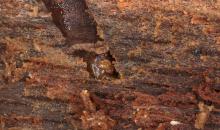
Sterculia nobilis, borehole with adult
Courtesy: Lukas Heringer, Chamber of Agriculture, North Rhine-Westphalia, Germany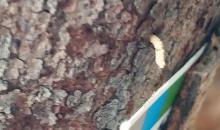
Typical discharge of drill dust "tooth-picks" Euwallacea fornicatus sensu lato on Ficus sp.
Courtesy: Toralf Pfannenstill, Plant Health Inspection, State Office for Rural Development, Agriculture and Land Reallocation, Brandenburg, Germany
